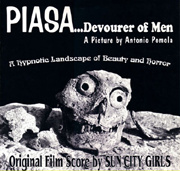Official Sun City Girls Discography:
Piasa...Devourer of Men

LP cover
1994: soundtrack LP (Abduction: ABDT-003)
2007: soundtrack CD (Abduction: ABDT-003)
Soundtrack for the unreleased film Piasa...Devourer of Men (1994), directed by Antonio Pomola.
"The bulk of this album was recorded at the same time as the Juggernaut LP (also a soundtrack), during two sessions in November and December of 1993. 'Perhaps One Woman of the Dark' was an incantation to make the newly-occupied Palatine studio our own, and was the first recording made there. Everything was recorded in the studio, except for 'At the Base of the Mountain of Noise' (recorded live at Larry Blake's in Berkeley, CA on Oct. 28, 1993) and 'A Lovely Demon Danced Upon' (recorded live at the Off Ramp in Seattle, WA on July 30, 1993)." — Scott Colburn
- Thunderbird
- Hatchling (Folklore of the Nest)
- At the Base of the Mountain of Noise
- Warning to Massatoga
- The Flying Leather Jackets of Pajarito
- Wingspan Eclipse the Moon
- Brilliant Pebbles
- Nighthunting
- Perhaps One Woman of the Dark
- Glowing Red Eyes
- Dolores
- A Lovely Demon Danced Upon
- Struggle Under Talons
- A Previously Unknown Sacrifice
- Ouatogo's Death Song
- 17 Mighty Arrows
- Lizard Copter
- Devourer of Men (Finale)
The song "Skull Block" was also recorded for this project but was not released.
About the Piasa Legend

Photo of the 1934 restoration of the Piasa painting on the Mississippi bluffs near Alton, IL.
The mythical Piasa (pronounced PIE-a-saw, and meaning "the bird that devours men") is a demonic being resembling a griffin described in the lore of the Illini Indians of southern Illinois. According to tribal oral history, the giant Piasa developed a taste for human flesh. Each morning and afternoon, the Piasa swooped down and carried off its human prey to a cave by the river, where it tore them to shreds and ate them. Many warriors tried to kill the invincible beast, only to fail and meet their own demise.
The great chief Ouatoga appealed to the Great Spirit, praying and fasting for nearly a full moon. At last he had a vision in which the Great Spirit revealed the Piasa was not protected beneath its wings. One night, as the entire tribe prayed and fasted, Chief Ouatoga took six of the finest warriors to the river's edge, near the Piasa's lair. At dawn, Chief Ouatoga used himself as a decoy and when the Piasa attacked him, the braves lept from their hiding places to fire one poisoned arrow each into the flesh beneath the wings. At last, the poison took effect and with a scream of agony, the Piasa released Chief Ouatoga and plunged into the river, disappearing forever. The next day the tribe's arrow maker, Tera-hi-on-a-wa-ka, mixed special paints and painted a picture of the Piasa on the bluff where the being had dwelled. The colors used symbolized war and vengeance (red), death and despair (black), and hope and triumph over death (green).
In 1673, Jesuit explorers Marquette and Joliet recorded seeing the painted engraving depicting Piasa on the face of a limestone bluff 50 feet above the water near their historic landing site at the confluence of the Illinois and Mississippi Rivers. Later explorers in the 17th and 19th centuries also recorded seeing this (or similar) engravings on the river bluffs.
In 1836 Professor John Russell of Bluffdale, Illinois, published an account of the Piasa in which he described venturing into a cave in the bluffs said to be where Piasa ate its prey. "The floor of this cave," Prof. Russel wrote, "throughout its whole extent was a mass of human bones. Skulls and other bones were mingled together in the utmost confusion. To what depth they extended I was unable to decide, but we dug to the depth of three or four feet in every quarter of the cavern and still found only bones. The remains of thousands must have been deposited here...."
The historical record is unclear, but it is believed that the original Piasa pictograph was somehow destroyed sometime in the 1800s. In 1924, a boy scout painted the traditional version of the Piasa on a cliff near Alton and presented it to the city. This figure has been repainted a number of times, including in 1934 and 1952. In later years, Southwestern High School in Alton adopted the Piasa Bird as its official mascot. The most recent restoration on the painting on the bluff was completed in 2000 by the American Legends Society.
More about the Piasa legend:- The Legend of the Piasa - written and compiled by Amber Downs, Illinois College.
- The Piasa Monster Bird - an article written in 1958 by Charles Harnett for the Illinois State Museum.
- The Legend of the Piasa Bird - from the Illinois Dept. of Natural Resources.